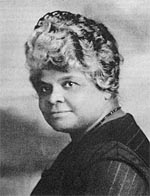![]()
Home
![]() Pre Katrina Home
Pre Katrina Home ![]() Articles
Articles
![]() Ida B. Wells: savvy data-user
Ida B. Wells: savvy data-user
Ida B. Wells
Journalist, civil rights leader,
mother of four (and savvy data-user)
More than 100 years ago, Ms. Wells used data to launch the anti-lynching movement. Her strategy was brilliant – learn what she did in this short article.
![]()
| by Denice Warren Ross |
|
|
Jan. 23, 2003 | From the post-civil war era to the middle of the 20th century, White lynch mobs terrorized African American communities across 44 states, with the Southern states bearing the brunt of this violence (1).
Although legislation to stop lynching was never fully enacted, the work of Ms. Ida B. Wells (1861-1930) and later the NAACP helped raise awareness about the scope of the terror and turned the tide of White public opinion against this injustice.
Ms. Wells wrote powerful narratives against lynching and supported her arguments with compelling statistics. Here's an excerpt from an article she wrote in 1900:
The Chicago Tribune, which publishes annually lynching statistics, is authority for the following: In 1892, when lynching reached high-water mark, there were 241 persons lynched...
[These lynchings] were brutal enough and horrible enough if it were true that [they] occurred only because of the commission of crimes against women - as is constantly declared by ministers, editors, lawyers, teachers, statesmen, and even by women themselves... Instead of lynchings being caused by assaults upon women, the statistics show that not one-third of the victims of lynchings are even charged with such crimes.
- From Lynch Law in America by Ida B. Wells-Barnett, 1900 (2)
Analyzing Ms. Wells' strategy...
Ms. Wells' strategy for data use was brilliant.
- She used data
to confirm
what African Americans already knew from anecdotal evidence.
(By publicizing
data of lynchings and where they occurred, Ms. Wells validated people's
real-world experiences and gave strength to their stories. Lynchings
were spread out around the country – data compiled in one place
was the only way to get a sense for the full extent of the problem so
people could organize against it.)
- And, she used data to counter the mistruths that supporters of lynching used to justify their atrocities. (Ms. Wells knew what the common misconceptions among White folk were when it came to lynchings. As she said in 1899, "Southern apologists justify their savagery on the ground that Negroes are lynched only because of their crimes against [White] women." By presenting an analysis of the number of lynching victims accused of rape, she proved these "Southern apologists" wrong.)
Another strategic move Ms. Wells made was to use a reputable data source. Those statistics collected by the Chicago Tribune weren't perfect – historians agree that the actual number of lynchings was higher than that reported – but they were the best data available at the turn of the 19th century. By using a widely accepted source for her data, she could focus on her anti-lynching argument rather than spending energy defending where her numbers came from.
The beginning of the end of lynching...
|
“...truth is mighty and the lynching record discloses the hypocrisy of the lyncher as well as his crime.” - Ida B. Wells-Barnett, from the 1909 pamphlet entitled Lynching (3) |
After peaking in 1892, lynchings gradually subsided. Starting in 1916, the NAACP began taking out ads in the New York Times, Atlanta Constitution and other national newspapers that extended the tradition of savvy data use established by Ms. Wells. In 1952, for the first year since records were kept, no lynchings were reported (4).
Politicians and the court systems weren't much help in the process, but Ms. Wells and her smart use of statistics played a powerful role in the turning of widespread public opinion against this most terrible institution.
Citations
(1) Lynchings
by State and Race, 1882-1968 (Tuskegee Institute, 1979)
http://www.law.umkc.edu/faculty/projects/ftrials/shipp/lynchingsstate.html
(2) Lynch Law
in America by Ida B. Wells (1900)
http://afroamhistory.about.com/library/blidabwells_lynchlawinamerica.htm
(3) Lynching
by Ida B. Wells (1909)
http://jefferson.village.virginia.edu/seminar/unit9/wellsquote.html
(4) Timeline on
Recorded Lynchings (Atlanta Journal-Constitution)
http://www.ajc.com/opinion/content/opinion/0402/28lynch_timeline.html?urac=n&urvf=10650274575270.18409155762232876
![]()
This article is a collaboration between the Greater New Orleans Community Data Center and the Jim Dunn Center for Anti-Racist Community Organizing at The People's Institute for Survival and Beyond in New Orleans. The author, Denice Warren Ross, is the Information Systems Designer at the Community Data Center.
Home ![]() Pre Katrina Home
Pre Katrina Home ![]() Articles
Articles ![]() Ida B. Wells: savvy data-user
Ida B. Wells: savvy data-user
![]()
|
Greater New Orleans Community Data Center
Last modified: January 28, 2003 |
